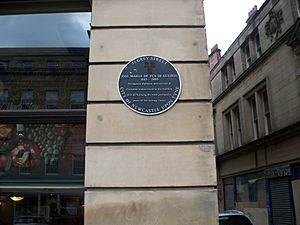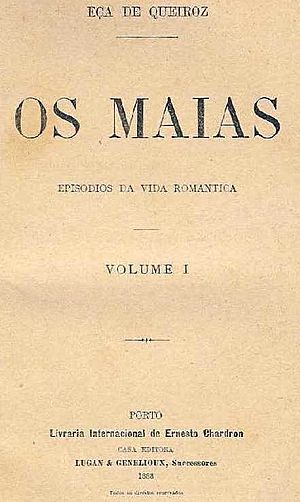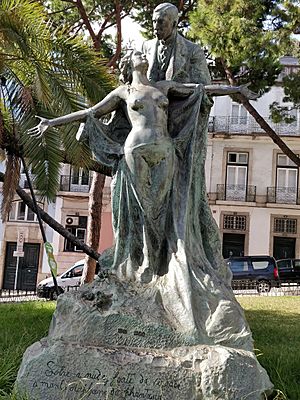Eça de Queiroz facts for kids
Quick facts for kids
Eça de Queiroz
|
|
|---|---|
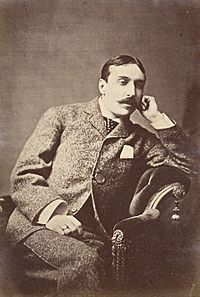 |
|
| Born | José Maria de Eça de Queiroz 25 November 1845 Póvoa de Varzim, Kingdom of Portugal |
| Died | 16 August 1900 (aged 54) Neuilly-sur-Seine, France |
| Occupation | Novelist/Consul |
| Nationality | Portuguese |
| Literary movement | Realism, Romanticism |
| Signature | |
José Maria de Eça de Queiroz (born November 25, 1845 – died August 16, 1900) was a very important Portuguese writer. Many people think he was the greatest Portuguese writer of his time. He wrote in a style called Realism, which means his stories showed life as it really was. Famous writers like Émile Zola and critics like Jonathan Keates thought he was as good as or even better than other great writers like Charles Dickens and Leo Tolstoy.
Contents
Biography of Eça de Queiroz
Eça de Queiroz was born in Póvoa de Varzim, Portugal, in 1845. When he was four years old, his parents got married. He lived with his grandparents until he was ten years old.
Early Life and Studies
At age 16, Eça went to Coimbra to study law at the University of Coimbra. There, he met the poet Antero de Quental. Eça's first writings were prose poems. They were published in the Gazeta de Portugal magazine. Later, these were collected in a book called Prosas Bárbaras ("Barbarous Texts").
He worked as a journalist in Évora. Then he returned to Lisbon. With his friend Ramalho Ortigão, he created a fun story. It was about a made-up adventurer named Fradique Mendes. This work was first published in 1900.
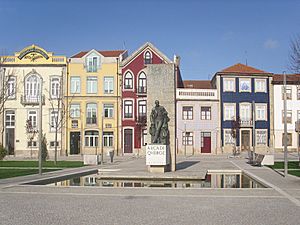
Travels and Early Novels
In 1869 and 1870, Eça de Queiroz traveled to Egypt. He saw the opening of the Suez Canal. This trip gave him ideas for many of his books. One famous work from this time is O Mistério da Estrada de Sintra ("The Mystery of the Sintra Road", 1870). He wrote it with Ramalho Ortigão, and Fradique Mendes appears in it.
Another book, A Relíquia ("The Relic"), was also written then. But it was only published much later, in 1887.
When he worked as a city administrator in Leiria, Eça de Queiroz wrote his first realist novel. It was called O Crime do Padre Amaro ("The Sin of Father Amaro"). This story is set in Leiria and first came out in 1875.
Diplomatic Career and Major Works
Eça then joined the Portuguese consular service. After working in Havana, he moved to Newcastle upon Tyne, England. He lived there from 1874 to 1879. There is a special plaque in his honor at 53 Grey Street.
His job included sending reports to Portugal. He wrote about the coal miners in England. He noted they earned more than miners in other places. They also got free housing and coal.
His years in Newcastle were very productive for his writing. He published a new version of O Crime de Padre Amaro in 1876. He also released another famous novel, O Primo Basílio ("Cousin Bazilio"), in 1878. During this time, he also started writing his "Letters from London." These were printed in a Lisbon newspaper. Later, they became a book called Cartas de Inglaterra.
By 1878, he had already named his masterpiece, Os Maias ("The Maias"). He mostly wrote this book while living in Bristol. It was finally published in 1888.
In 1886, he married Maria Emília de Castro in Lisbon. She joined him in Bristol. They later moved to London, and Eça traveled to Bristol for work. He often visited London before this arrangement.
Eça was a well-read person who knew a lot about English literature. He found English society interesting, even if he didn't always love it. He once said, "I detest England, but this does not stop me from declaring that as a thinking nation, she is probably the foremost." He stayed in England for about fifteen years.
Later Life and Death
Eça had liberal political ideas. In 1898, he became more worried about the future of Portugal and Europe. He described himself as a "vague, saddened anarchist," meaning he felt a bit lost and unhappy with how things were going.
In 1888, he became the Portuguese consul-general in Paris. He had actively sought this job. He lived in Neuilly-sur-Seine and kept writing. He wrote newspaper articles called Ecos de Paris ("Echoes from Paris"). He also wrote literary criticism.
Eça de Queiroz died in 1900. He was first buried in a family tomb in Lisbon. Later, his body was moved to a grave in Santa Cruz do Douro Cemetery in Portugal. His son, António Eça de Queiroz, later held a government position.
Works by Eça de Queiroz
Eça de Queiroz wrote many important novels and stories. Here are some of his well-known works:
- O Mistério da Estrada de Sintra ("The Mystery of the Sintra Road") (1870), with Ramalho Ortigão
- O Crime do Padre Amaro ("The Sin of Father Amaro", 1875, revised 1876, revised 1880)
- O Primo Basílio ("Cousin Bazilio", 1878)
- O Mandarim (The Mandarin, 1880)
- A Relíquia (1887) ("The Relic", 1994)
- Os Maias ("The Maias", 1888)
- Uma Campanha Alegre ("A Cheerful Campaign") (1890–1891)
- Correspondence of Fradique Mendes (1890)
- A Ilustre Casa de Ramires (1900); ("The Illustrious House of Ramires", 2017)
Posthumous Works
These are works that were published after Eça de Queiroz died.
- A Cidade e as Serras ("The City and the Mountains", 1901)
- Contos ("Stories") (1902)
- Prosas Bárbaras ("Barbarous Texts", 1903)
- Cartas de Inglaterra ("Letters from England") (1905)
- Ecos de Paris ("Echoes from Paris") (1905)
- São Cristóvão, published in English in 2015 as Saint Christopher. (1912)
- A Capital ("To the Capital") (1925)
- Alves & C.a ("Alves & Co."). (1925)
Periodicals Eça de Queiroz Wrote For
Eça de Queiroz also wrote for several newspapers and magazines during his life:
- Gazeta de Portugal
- As Farpas (The Barbs)
- Diário de Notícias
Translations of His Works
Eça de Queiroz's books have been translated into about 20 different languages. This includes English, so many people around the world can read his stories.
Since 2002, many of his novels and short stories have been translated into English by Margaret Jull Costa. These have been published in the UK by Dedalus Books.
Some of his translated works include:
- A Cidade e as serras (The City and the Mountains)
- A Ilustre Casa de Ramires (The Illustrious House of Ramires)
- A Relíquia (The Relic)
- A tragédia da rua das Flores (The Tragedy of the Street of Flowers)
- Alves & Cia (Alves & Co.)
- Cartas da Inglaterra (Letters from England)
- O Crime do Padre Amaro (The Sin of Father Amaro or The Crime of Father Amaro)
- O Mandarim (The Mandarin)
- O Primo Basílio (Cousin Bazilio)
- Os Maias (The Maias)
- O Mistério da Estrada de Sintra (The Mystery of the Sintra Road)
- São Cristóvão (Saint Christopher)
Film and TV Adaptations
Many of Eça de Queiroz's novels have been made into movies and TV shows. This shows how popular and important his stories are.
Film Adaptations
- O Crime do Padre Amaro has been made into two films. One was a Mexican film in 2002. The other was a Portuguese film in 2005. The Portuguese film was very popular, becoming the most-watched Portuguese movie at the time.
- A movie version of O Mistério da Estrada de Sintra was made in 2007.
- In 2014, director João Botelho released a film called Os Maias. It was based on the novel of the same name.
Television Adaptations
- In Brazil, Rede Globo made a TV series of O Primo Basílio in 1988.
- In 2001, Rede Globo also created a TV series based on Os Maias.
Theatre Adaptations
The Galleon Theatre Company in London has also adapted Eça de Queiroz's novels for the stage.
- In 2001, they performed Cousin Basílio.
- In 2002, they performed The Maias.
See also
 In Spanish: José Maria Eça de Queirós para niños
In Spanish: José Maria Eça de Queirós para niños


